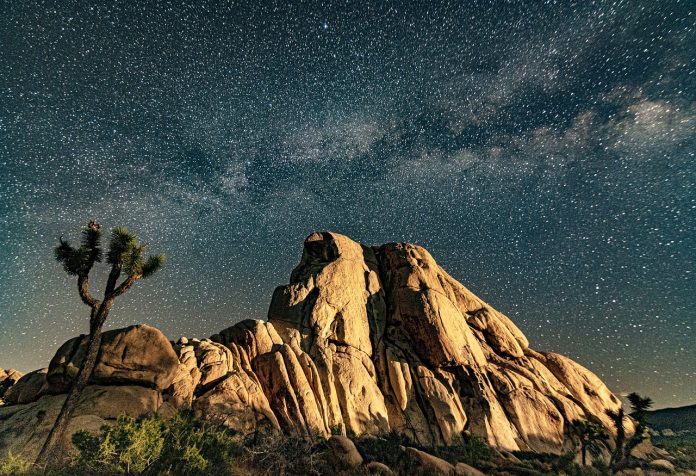Table of Contents

About Joshua Tree National Park California
The history of Joshua Tree National Park is as unique and fascinating as the twisted, spiky trees that give this desert landscape its name. But what is it about this place that has drawn humans to its rugged beauty for thousands of years? It’s easy to understand once you begin to uncover the stories etched into the very rocks and plants of this unique area.
The History of the Park
Joshua Tree National Park California, established as a national monument in 1936 and later upgraded to a national park in 1994, has long been a site of human activity. The park’s rich history is marked not just by its famous Joshua trees (Yucca brevifolia), but also by the numerous archeological sites that dot the landscape. These sites tell the story of early Native American inhabitants, ranchers, miners, and homesteaders who have all left their mark on the land.
The park’s historical significance isn’t merely confined to these human imprints; it also lies in its natural history. With geological features that date back hundreds of millions of years, the park serves as a window into Earth’s past, making it a treasure trove for both geologists and historians alike.
The Cultural Heritage of the Area
The cultural tapestry of Joshua Tree is rich and diverse, woven with the threads of numerous groups and communities. Long before it became a hub for artists and adventurers, it was home to Indigenous people like the Cahuilla, Chemehuevi, Serrano, and Mojave. These groups found ways to thrive in the harsh desert environment, harvesting the Joshua tree’s tough leaves for basket weaving and eating its flowers and seeds. Petroglyphs and pictographs found within the park boundaries are silent testaments to this lasting relationship with the national park, offering insights into the beliefs and daily lives of the its first inhabitants.
The area’s mining and cattle ranching era brought significant change through the 19th and 20th centuries. Evidence of this period remains visible in the form of historic ranches, mines, and the ruins of old settlements, providing a glimpse into the challenging lives of the settlers who sought fortunes and new beginnings in the American West.
Geological Wonders of Joshua Tree
Imagine standing amidst a landscape where massive boulders defy gravity, and rocks tell tales dating back millions of years. A familiar subject for a Nat Geo photoshoot, are the surreal features of Joshua Tree National Park California. These natural sculptures offer more than just beauty; they are a testament to Earth’s dynamic history.
Rugged Rock Formations
The park’s distinctive rock formations are a magnet for photographers and nature lovers alike. You’ll find yourself awestruck by the sight of Skull Rock, with its hollowed eyes formed by erosion. Or consider the Wonderland of Rocks, an intricate maze of granite monoliths and narrow canyons that seem to transport you to another world. These rocks are not only visually stunning, but they also tell a story of the forces shaping our planet.
Millions of Years in the Making
To understand these formations, we must travel back in time, over 100 million years ago, when molten liquid heated by the Earth’s core oozed to the surface and cooled, forming granite. Fast forward through ages of tectonic shifts and erosion, the once buried granite was exposed, sculpted by wind and water into the spectacle we see today. The result is a panorama of jumbled rocks, spires, and domes, each piece uniquely molded by the hands of time.
A Climber’s Paradise
For rock climbers, Joshua Tree is nothing short of heaven. The park boasts over 8,000 climbing routes, catering to every skill level. Iconic spots like Echo Cove and Hidden Valley Campground are not just playgrounds for the adventurous; they hold a special place in the heart of the entire climbing community. These sites have been instrumental in the development of modern climbing techniques and continue to challenge and inspire climbers from around the world.
High Desert vs Low Desert
Joshua Tree National Park California straddles two distinct desert ecosystems: the Mojave Desert, commonly referred to as the high desert, and the Colorado Desert, part of the larger Sonoran Desert, known as the low desert. This unique geographical and ecological juxtaposition results in a vibrant tapestry of biodiversity that characterizes the park.
The Mojave Desert, where the iconic Joshua trees flourish, occupies the higher, western section of the park. This region is cooler and receives more precipitation than its counterpart, fostering a landscape dominated by these peculiar yucca plants, along with piñon pines, junipers, and scrub oaks. The Mojave’s elevation lends itself to dramatic temperature swings, from blistering daytime heat to chilly nights, creating a challenging yet life-sustaining environment for the inhabitants on this side of the park.
Descending into the eastern parts of Joshua Tree, the park transitions into the Colorado Desert. Here, the environment shifts markedly. The lower elevation means hotter temperatures and less rainfall, shaping an ecosystem where hardy cacti and the sprawling ocotillo plant become more common sights.
Plants and Animals in the Park
Joshua Tree National Park is not just an assembly of rocks and boulders but a lively, breathing ecosystem teeming with diverse species. The flora and fauna here have adapted to thrive in the park’s harsh desert environment.
The Variety of Plant and Animal Species
The park’s namesake Joshua trees, known scientifically as Yucca brevifolia, stand as sentinels in this arid landscape. They are joined by over 750 plant species that paint the scenery with vibrant colors, especially during spring bloom. From the cholla cactus with its deceivingly soft appearance to the hardy creosote bushes, each plant plays a role in the desert’s ecology. In terms of fauna, the park is home to a fascinating array of creatures. Desert tortoises crawl slowly across the terrain, while bighorn sheep navigate the rocky outcrops with ease. The night brings out the coyotes’ howls and the fluttering of bats, as they all take part in the desert nightlife.
The Importance of Conservation Efforts
Conservation is key in Joshua Tree National Park California due to its unique ecosystem that supports such rare species. The delicate balance of this desert environment means even small changes can have far-reaching consequences. One example is the Joshua tree itself which faces threats from climate change and habitat loss. Efforts like limiting off-road driving and enforcing strict camping regulations help minimize human impact. Protecting the park’s biodiversity ensures that it continues to be a place where both wildlife and people can flourish.
Planning Your Trip to Joshua Tree National Park California
Here are some essentials for making your trip both memorable and responsible when visiting the park:
What to Pack
Packing wisely is key to enjoying the rugged beauty of Joshua Tree. Daytime temperatures can soar, while nights may bring a chill, so layering is crucial. Bring light, breathable clothing, a wide-brimmed hat, and sturdy hiking boots. Sunscreen and sunglasses are vital to protect against the harsh sun, and remember to pack plenty of water—hydration is paramount in this desert zone. Don’t forget your camera, as the park offers a stunning backdrop that you’ll want to remember forever.Where to Stay
From rustic campgrounds to cozy lodges, Joshua Tree offers a variety of accommodations. Camping within the park allows you to immerse yourself in nature, with several campgrounds providing different levels of amenities. For those seeking a bit more comfort, nearby towns like Twentynine Palms and Joshua Tree Village offer hotels and vacation rentals. Whichever you choose, ensure to book well in advance, as spots fill up quickly, especially during peak seasons.
Navigating the Park
Getting around Joshua Tree is part of the adventure. The park has clearly marked roads that lead to the various points of interest. A reliable map is your best friend here, and while GPS can be helpful, don’t rely solely on technology as service can be spotty. Stop by the visitor centers to get the latest information on road conditions and trail closures. They’re also great places to learn about the park’s history and ecosystems from knowledgeable rangers.
Recreational Activities Available for Visitors
- Hiking: Hiking trails range from easy nature walks to challenging treks with rewarding views.
- Camping: Experience the desert under a canopy of stars at one of the park’s campgrounds.
- Rock Climbing: With its iconic boulders and rock formations, Joshua Tree is a climber’s paradise.
- Stargazing: The park’s dark skies make it an ideal spot for astronomy enthusiasts.
Each activity offers a unique way to connect with the park’s landscapes and wildlife. Remember to prepare accordingly and respect the natural surroundings to ensure a safe and enjoyable experience.
Key Historical Sites to Visit
Be sure to visit sites like the Keys Ranch, which tells the story of early 20th-century life in the desert, or the petroglyphs at Barker Dam, hinting at the rich Indigenous heritage of the region. Both of these sites are on the National Register of Historic Places, and provide a fascinating glimpse into the past lives that shaped the park.
Tips for Making the Most of a Visit to Joshua Tree National Park California
To truly embrace all that Joshua Tree has to offer, start early to beat the heat and crowds. Always stay on designated trails to protect fragile habitats and take nothing but photos, leaving rocks, plants, and artifacts as you find them. Finally, attend a ranger-led program to deepen your appreciation of this remarkable environment.
The Importance of Responsible Tourism and Leaving No Trace
Responsible tourism isn’t just a choice; it’s a commitment to preserving the magic of Joshua Tree for others. Practice Leave No Trace principles by disposing of waste properly, minimizing campfire impacts, and respecting wildlife. By treading lightly and leaving no trace, you help ensure the park’s wonders endure for future explorers.
FAQs
Do you have questions before your adventure to Joshua Tree National Park California? Let’s tackle some frequently asked questions that might be on your mind.
What is the Best Time of Year to Visit?
The park welcomes visitors year-round, but the best time to visit is during the cooler months, from October to April. During this period, the daytime temperatures are pleasant for hiking and exploring. The summer months can be extremely hot, with temperatures often soaring above 100°F (38°C), making outdoor activities challenging.
Can I Bring My Pet Along?
While pets are allowed in Joshua Tree National Park California, there are strict rules to protect wildlife and ensure everyone’s safety. Pets must be on a leash no longer than six feet at all times and cannot stray more than 100 feet from any road, picnic area, or campground. They’re not allowed on the trails or in the backcountry, so it may be best to leave furry friends at home if you plan to fully explore the park.
Are There Any Entrance Fees?
Yes, there is a fee to enter Joshua Tree National Park California. A seven-day park entrance pass for a vehicle costs $30, while individuals entering by foot or bicycle will pay $15. For those frequenting the park or other federal lands, an annual America the Beautiful Pass could be a cost-effective option at $80, granting unlimited access to national parks across the country.
What Should I Do in Case of an Emergency?
For emergencies, dial 911. Remember that cell service can be spotty in the park, so it’s wise to inform someone of your travel plans before you set out. In case of minor incidents, ranger stations and visitor centers can offer assistance during their operating hours.
Is Camping Available and Do I Need a Reservation?
Camping is one of the most popular ways to experience Joshua Tree National Park California. The park has several campgrounds, some of which require reservations, especially during the peak season. It’s recommended to book well in advance through the official National Park Service reservation system. There are also first-come, first-served campgrounds, but these fill up quickly, so arrive early if you’re planning to snag a spot.
Support the Park
Support for the park goes beyond simply visiting; it’s about engaging with the environment and becoming part of its ongoing story. Let’s explore how you can immerse yourself in the magic of this unique landscape and become an advocate for its preservation:
Participate in Ranger Programs
One of the best ways to connect with Joshua Tree National Park California is through the park ranger-led programs. These informative sessions are designed to enhance your understanding of the park’s ecosystems, history, and cultural significance. Whether it’s a guided hike under the starlit sky or a talk on the delicate desert flora, these programs are a great resource if you have any questions about the national park. Check the visitor center or the park’s official website for schedules and topics.
Join the Friends of Joshua Tree
Another fantastic way to deepen your connection with Joshua Tree National Park California is by joining the Friends of Joshua Tree, a community of passionate individuals dedicated to supporting the park. As a member, you’ll be part of advocacy efforts, educational programs, and special events that celebrate and protect this national treasure. Membership often comes with perks like newsletters and discounts on park merchandise, too.
Adopt a Joshua Tree
Did you know you can adopt a Joshua Tree or other native plant? Various programs allow you to sponsor the planting and care of native species within the park. This unique form of support helps to ensure the survival of the plants that give the park its name and contributes to habitat restoration efforts. It’s a meaningful way to leave a lasting legacy and promote the park’s diverse ecosystem.
Citizen Science Projects
If you’re intrigued by science and research, consider getting involved in citizen science projects. These initiatives encourage visitors to contribute to ongoing scientific studies by reporting wildlife sightings, weather conditions, or plant blooming times. Your observations can provide valuable data that helps researchers track ecological changes and manage the park more effectively. It’s a fun and educational activity for families and individuals alike.
Attend Special Events and Workshops
The park occasionally hosts special events and workshops that offer unique ways to engage with the environment. From photography workshops capturing the stunning landscapes to night sky programs that reveal the wonders of the cosmos, these events are designed to educate and inspire. Keep an eye on the park’s event calendar to join in on these memorable experiences.
Donate to the National Park Foundation
Donating to the National Park Foundation is perhaps one of the most direct ways to support Joshua Tree National Park California and ensure its preservation for future generations. The National Park Foundation works closely with the National Park Service to enhance the entire national parks system, and support our national treasures. These projects may include trail maintenance, wildlife conservation efforts, and educational programs aimed at nurturing a deeper love and respect for the natural world. They’re also a great asset for when you plan your trip to the parks. Follow the National Park Foundation on social media to connect with the parks and keep up to date with all the work the foundation is doing.









